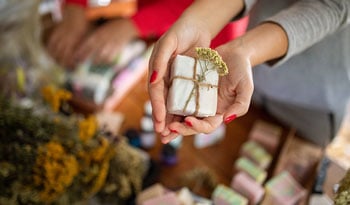How to Make Sustainable Beauty Ingredient Choices
DISCLAIMER:This blog does not intend to provide diagnosis...
- In this article:
- Greenwashing: Are Brands Trying to Fool Us?
- How to Choose More Sustainable Beauty Products
- Remember: Natural Doesn’t Always Mean Sustainable

Sustainability is something we hear more about every year, and it’s important in the beauty realm, too. Consumers want to know what products work the best but also, what is best for the environment, and our bodies? People want to know what brands are doing to eliminate product toxicity and improve our planet.
As brands make commitments to sustainability, we see companies focusing on the lifecycle of how they make their products and what takes place after the products are in the hands of consumers. There are many things to think about when considering the sustainability of a beauty product: like how ingredients are sourced, and whether the ingredients used are environmentally friendly. There are manufacturing emissions to consider, as well as packaging and whether or not it can be recycled.
And it’s not only beauty brands that have to commit to making changes—as consumers, we must make changes too. Let’s identify ways we can contribute to a healthier and safer environment by choosing sustainable beauty products, eliminating waste, and being mindful about the choices we make.
Greenwashing: Are Brands Trying to Fool Us?
There is a lot of money to be made in the global beauty industry and many thousands of products and brands to choose from. Are they all onboard with a plan to create more sustainable products? The answer is … no.
Some brands take sustainability very seriously and have long term strategies to improve the impact of their products on consumers and the environment. Other brands are looking to capitalize on the importance consumers place on sustainable products and have grasped onto buzz words or phrases such as clean beauty, green beauty, and organic, to name a few. The use of these words to describe products is not regulated in the beauty industry. Consumers may be deceived and think they are choosing sustainable products that contain environmentally friendly ingredients. However, these ingredients in the products may be minimal and the products are not necessarily safer for the environment.
These marketing tactics are referred to as greenwashing, and they are something consumers should be aware of. Provenance is an independent organization that works with brands to verify and make sustainability information readily available to consumers. One of their key objectives is to protect consumers from greenwashing.
How to Choose More Sustainable Beauty Products
There are some key ingredients that make sense to avoid when shopping for sustainable beauty products, and I’ll detail them here, along with some better alternatives.
Exfoliating Microbeads
Many products that are used to exfoliate the face and body use tiny plastic beads that pollute rivers, lakes, and oceans. The marine life consumes the beads—that means that humans may end up consuming them as well. These plastic microbeads do not dissolve and are accumulating at an alarming rate in the environment. Microbeads are also used in toothpaste, lip gloss, shampoo, sunscreen, and eyeliner. The problem with microbeads was widely recognized and in 2015, President Obama and Congress passed the “Microbead-Free Waters Act of 2015” into law. This phased out the use of plastic microbeads by 2019 in all manufactured products. However, you will still find them on ingredient lists today.
To identify whether a product contains microbeads, look for these ingredients on the label:
- Microbeads
- Micro abrasives
- Acrylate copolymer
- Polypropylene
- Polyethylene
Instead of using facial cleansers and exfoliators that contain the above ingredients, try products that use exfoliating rice or fruit enzymes, glycolic acid, or mandelic acid. These ingredients are safe for the environment and highly effective. Plus, they will leave your skin smooth and glowing. One of my favorite cleansers contains pineapple enzymes that gently exfoliate. I’m always thrilled at how my skin looks after using it.
You can find some incredible body scrubs that use natural physical exfoliators like sugar and salt. These are usually combined with essential oils and leave your skin feeling silky smooth. There are also safe chemical exfoliating body scrubs. If you are looking for a safe chemical exfoliation, you can find body scrubs with glycolic acid, lactic acid, AHA, BHA and fruit enzymes that will give a terrific result after the first use.
BHA and BHT
BHA and BHT are synthetic antioxidants used as preservatives in beauty products. These ingredients are banned in multiple countries for health reasons. Both are believed to be harmful to the environment, humans, and toxic to marine life. The chemicals are often used to preserve lipsticks and moisturizers. However, you will find BHA and BHT in many different cosmetic products. These questionable preservatives are also used in foods that are produced in the United States and are definitely something consumers need to be looking for.
Canada is one of the countries that has banned the use of BHA and BHT. Interestingly, I looked at the ingredient list on a box of cereal that is very popular with children. In the U.S., the label noted BHT was used for freshness. In the Canadian cereal product produced by the same parent company, the BHT was absent. When I witness issues like this first-hand, I realize how important it is for consumers to be aware of what is in the products they are buying.
To identify if a product contains BHA or BHT, look for these ingredients on the label:
- Butylated hydroxyanisole (BHA)
- Butylated hydroxytoluene (BHT)
The good news is that there are so many face moisturizers that don’t contain these preservatives. Definitely do a check of the ingredients, but chances are that you can shop with confidence from a trusted source of beauty products.
Phthalates
Phthalates may be a familiar term to you, but could you actually spot them on a product label? Phthalates are a family of chemicals found in cosmetics, foods, toys, detergents, and many other products. While you may avoid them in one place, you may be getting exposed in others.
In the beauty industry, they are most often used in perfume, hair spray, shampoo, soap, nail polish, and moisturizers. In nail polish, these chemicals reduce the polish from cracking. And in hairspray, they keep the product from getting too stiff. In fragrances, they are used as solvents. Perhaps they are popular additives because they are versatile and quickly make a product behave the way a manufacturer would like it to.
In the U.S., phthalates have been banned in toys but can still be found in other products we use on a daily basis. They are known to cause skin irritation and an array of other discomforting symptoms for some people, in addition to having far, far more serious health consequences. In 2014, DiDp, one of the known phthalates that have been banned in the use of children’s products. It’s unsettling to know ingredients may be banned in children’s products and on warning lists but companies still use them. They may not put certain ingredients into making toys, but everyone, including children, can unknowingly be exposed by consuming products that contain the chemicals in their daily life. The Food and Drug Administration continues to monitor the connection between these chemicals and human health but hasn’t gathered enough evidence to take regulatory action.
To identify products with phthalates, look for these ingredients on the label:
- DBP (dibutyl phthalate)
- DnOP (di-n-octyl phthalate)
- DiNP (diisononyl phthalate)
- DEP (diethyl phthalate)
- BBzP or BBP (benzyl butyl phthalate)
- DEHP (di 2-ethylhexyl phthalate)
- DiDP (diisodecyl phthalate)
- DnHP (di-n-hexyl phthalate)
There are well over 500 phthalate-free shampoos, conditioners, and styling products that are far more environmentally friendly choices for your hair care.
While phthalates may be banned from use in making children’s toys, you can still find them in personal care products for children. It’s important to choose toothpaste, diaper rash cream, moisturizers, and shampoos that are free of any phthalates and safe for your baby and our planet.
Synthetic Fragrances
You probably aren’t surprised to see synthetic fragrance on the list of non-sustainable ingredients in beauty products. Fragrances are a true culprit when it comes to sustainability because the ingredients that go into making a fragrance do not need to be included on labels—they are protected by “trade secret” laws. The source of ingredients and chemicals remains a mystery to consumers. And synthetic fragrance can be found in everything from baby products, sunscreens, cleansers, soaps, moisturizers, body creams, and so much more. Synthetic fragrance is not processed out of wastewater, and it makes its way to the ocean. There, it can accumulate in the soft tissues of marine life. And since the ingredients are a mystery to consumers, it’s unknown what chemicals in synthetic fragrances do to humans and the rest of the environment.
To identify products with synthetic fragrance, the label will indicate it contains fragrance.
Instead of perfumed soaps, opt for fragrance-free soap. If you would like naturally scented soap and cleansers, a great option are those that incorporate essential oils. Some essential oils offer skincare and health benefits but also the scent is lovely and tolerated by people better than synthetic fragrance. Synthetic fragrance has been known to wreak havoc with people who have allergies. Whether it’s a woody scent or something floral, essential oils can be combined to create beautiful scents.
Silicones
Another prevalent ingredient that is hard to escape is silicone and siloxanes. Silicones are used in anti-aging products, makeup, hair care, and many other beauty products. It’s not a biodegradable product, but it can be recycled. The catch here is all silicone is not recycled or recycled safely. Under those circumstances, it can pose a threat to the environment. Environmental research companies around the world have identified these chemicals in marine life that may be consumed by humans. However, silicone is a more mindful option than plastic. It is made from sand and doesn’t involve mining for crude oil like plastic does.
The key to being less wasteful with silicone is knowing what quality of product you are getting. Chemicals used in the manufacturing of cheap silicone often leak into the environment. To ensure you obtain high-quality silicone that will prevent toxins in your home and our environment, look for products that are marked as food grade or medical grade. This indicates the silicone is of the highest quality. Also, some silicone products do have an FDA stamp of approval. These are much better options, and help to lessen waste in the environment from the use of plastic or low-quality silicones.
To identify products with silicone, look for these ingredients on the label:
- Cyclopentasiloxane
- Dimethicone
- Cyclomethicone
- Cetearyl methicone
- Cyclohexasiloxane
Silicone in beauty products and packaging isn’t necessarily a negative, but keep in mind what grade of silicone you are purchasing, and whether it makes sense for your skin type. It has benefits such as making skin appear smoother and increasing the water resistance of products. However, it sits on the surface of your skin, so if you tend to break out easily or have oily skin, silicone may not be the best option for you. In hair products, silicone helps to eliminate frizz. Beauty brands may choose silicone in packaging over plastic because it eliminates waste when recycled properly.
If you’d like to avoid silicone altogether, you can find hundreds of silicone-free moisturizers and hair care products. Otherwise, now you have a better understanding of how to be mindful when choosing products that contain silicone.
Remember: Natural Doesn’t Always Mean Sustainable
I wish I could say this is everything to look for when making sustainable beauty choices, but there are other ingredients to consider. This list is a good start and touches on some of the more sensitive and concerning ingredients and practices around sustainability in beauty products. Remember that everything that states it is all-natural is not necessarily sustainable, because natural resources can be depleted.
There are other things to consider such as how ingredients are sourced and whether they are safely used in manufacturing. Plus, not all-natural ingredients are necessarily safe for consumption. Beware of greenwashing! Sustainability is a broad topic and one I hope to see more about in the coming year.

 By Janine Hill
By Janine Hill


